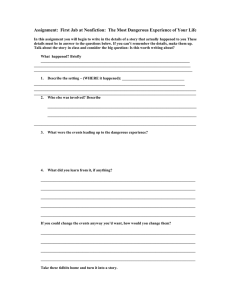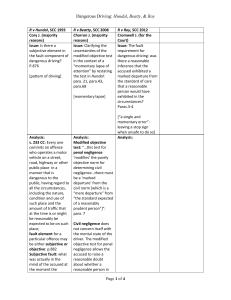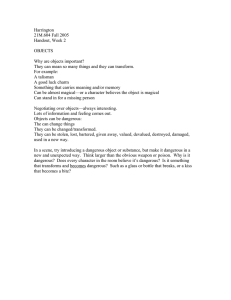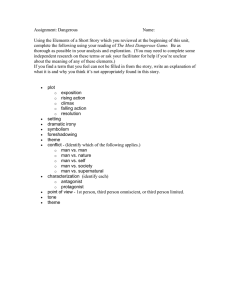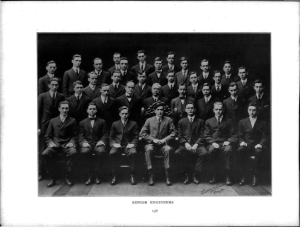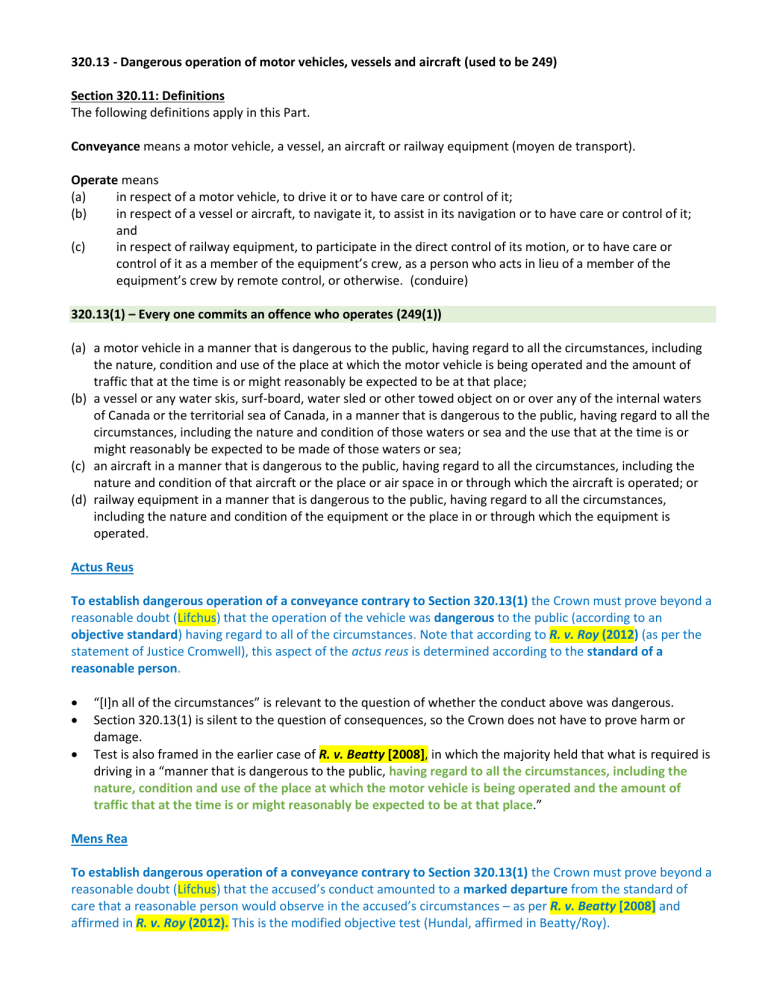
320.13 - Dangerous operation of motor vehicles, vessels and aircraft (used to be 249) Section 320.11: Definitions The following definitions apply in this Part. Conveyance means a motor vehicle, a vessel, an aircraft or railway equipment (moyen de transport). Operate means (a) in respect of a motor vehicle, to drive it or to have care or control of it; (b) in respect of a vessel or aircraft, to navigate it, to assist in its navigation or to have care or control of it; and (c) in respect of railway equipment, to participate in the direct control of its motion, or to have care or control of it as a member of the equipment’s crew, as a person who acts in lieu of a member of the equipment’s crew by remote control, or otherwise. (conduire) 320.13(1) – Every one commits an offence who operates (249(1)) (a) a motor vehicle in a manner that is dangerous to the public, having regard to all the circumstances, including the nature, condition and use of the place at which the motor vehicle is being operated and the amount of traffic that at the time is or might reasonably be expected to be at that place; (b) a vessel or any water skis, surf-board, water sled or other towed object on or over any of the internal waters of Canada or the territorial sea of Canada, in a manner that is dangerous to the public, having regard to all the circumstances, including the nature and condition of those waters or sea and the use that at the time is or might reasonably be expected to be made of those waters or sea; (c) an aircraft in a manner that is dangerous to the public, having regard to all the circumstances, including the nature and condition of that aircraft or the place or air space in or through which the aircraft is operated; or (d) railway equipment in a manner that is dangerous to the public, having regard to all the circumstances, including the nature and condition of the equipment or the place in or through which the equipment is operated. Actus Reus To establish dangerous operation of a conveyance contrary to Section 320.13(1) the Crown must prove beyond a reasonable doubt (Lifchus) that the operation of the vehicle was dangerous to the public (according to an objective standard) having regard to all of the circumstances. Note that according to R. v. Roy (2012) (as per the statement of Justice Cromwell), this aspect of the actus reus is determined according to the standard of a reasonable person. “[I]n all of the circumstances” is relevant to the question of whether the conduct above was dangerous. Section 320.13(1) is silent to the question of consequences, so the Crown does not have to prove harm or damage. Test is also framed in the earlier case of R. v. Beatty [2008], in which the majority held that what is required is driving in a “manner that is dangerous to the public, having regard to all the circumstances, including the nature, condition and use of the place at which the motor vehicle is being operated and the amount of traffic that at the time is or might reasonably be expected to be at that place.” Mens Rea To establish dangerous operation of a conveyance contrary to Section 320.13(1) the Crown must prove beyond a reasonable doubt (Lifchus) that the accused’s conduct amounted to a marked departure from the standard of care that a reasonable person would observe in the accused’s circumstances – as per R. v. Beatty [2008] and affirmed in R. v. Roy (2012). This is the modified objective test (Hundal, affirmed in Beatty/Roy). 320.13(1) / 249(1)(a) Not more than 5 years, or summary conviction AR – objectively dangerous MR – marked departure o o o o o Operates motor vehicle (definition) In a manner that is dangerous to the public (objective standard) (Roy) o Cromwell: determined according to standard of the RP Having regard for the circumstances (nature, condition, use of place, amount of traffic at time or might reas be expected to be at that place) (Beatty) No consequence needed Mention voluntariness! 249(2) – Charging subsection (not in 320) Modified Objective (Hundal) Section is silent on this, would usually imply subj (ADH), but courts have said appropriate MR for DD is objective (Hundal) Hundal: Consider licensing, health issues Look at surrounding context, applied with flexibility Driving is automatic, hard to make out SMR Beatty: marked departure from SOC RP would observe in the accused’s circumstances includes momentary lapses of attention/concentration Roy – would reasonable person have foreseen risk and avoided (not looking at consequences) MR often inferred, but evidence may negate or cast doubt (Beatty) take actual state of mind into account 320.13(2) – Dangerous operation causing bodily harm (249(3)) Everyone commits an offence who operates a conveyance in a manner that, having regard to all of the circumstances, is dangerous to the public and, as a result, causes bodily harm to another person. Actus Reus: To establish dangerous operation of a conveyance causing bodily harm causing bodily harm contrary to Section 320.13(2) the Crown must prove that the operation of the vehicle was dangerous to the public (according to an objective standard) having regard to all of the circumstances. Note that according to R. v. Roy (2012) (as per the statement of Justice Cromwell), this aspect of the actus reus is determined according to the standard of a reasonable person; and that the conduct complained of caused bodily harm to another person. According to Section 2 of the Code, “bodily harm” means any hurt or injury to a person that interferes with the health or comfort of the person and that is more than merely transient or trifling in nature. Key cases on the meaning of “bodily harm” include: R. v. Dixon (1988), R. v. Dorscheid (1994), R. v. Garrett (M.G.) (1995), R. v. Giroux (1995), R. v. Robinson (2001) and R. v. Rabieifar (2003). Mens Rea To establish dangerous operation of a conveyance causing bodily harm causing bodily harm contrary to Section 320.13(2) The Crown must prove that the accused’s conduct amounted to a marked departure from the standard of care that a reasonable person would observe in the accused’s circumstances – as per R. v. Beatty [2008] and affirmed in R. v. Roy (2012). 320.13(2) / 249(3) Indictable offense, liable for prison not more than 10 yrs AR o o MR Commits offence under subsection (1) – conduct and circumstances And thereby causes bodily harm to another person – consequence (see Assault worksheet for harm) Marked departure (Roy, affirmed in Beatty) 320.13(3) – Dangerous Operation of a conveyance causing death (249(4)) Everyone commits an offence who operates a conveyance in a manner that, having regard to all of the circumstances, is dangerous to the public and, as a result, causes the death of another person. 320.13(2) / 249(4) Indictable offense, liable for prison not more than 14 yrs AR o o MR Commits offence under subsection (1) – conduct and circumstances (see subsection 1) And thereby causes the death of another person - consequences o Marked departure (Roy, affirmed in Beatty) from SOC expected of RP in circum Actus Reus – from 320.13(1) … and that the conduct complained of caused the death of another person. Mens Rea – same as 320.13(1) Note on AR of DD Dangerous is objective standard – if Crown can prove that driving was, in all the circumstances, objectively dangerous (that a RP would regard it as dangerous) then AR will be made out (Beatty, Roy) – obj standard Beatty (2008): Acquitted (trial acquitted, BCCA allowed appeal by Crown) Accused zoned out and crossed centre line, caused accident and killed people Manner of driving (was it dangerous in the circumstances), not the consequences Witnesses saw his vehicle driven properly prior to accident, and inspection showed vehicle was fine AR was made out, but MR wasn’t – no marked departure MR is generally inferred from the act, the evidence may cast reasonable doubt on this inference (like here) Minority: said AR wasn’t made out, because crossing did not constitute a MD from norm of driving, and that MR wasn’t made out because it didn’t fall below SOC expected of a RP in circumstances ***The more dangerous the conduct (AR), the more likely we are to make out the MR Roy (2012): Acquitted, trial judge erred in determining DD, wasn’t marked departure Low visibility (fog, snow, steep hill), proceeded onto highway into path of tractor-trailer. Passenger killed, accused lived. Note on MR of DD Hundal (1993): Accused ran a red light while driving an overloaded dump truck, killed driver of oncoming car Defence: should be subj MR and should be acquitted – didn’t foresee the risk of harm of running red light Cory: relevant test is modified objective test Start with objective standard (what we expect RP to foresee in terms of risk) then modify it according to the subjective knowledge of the accused in circumstances Court looks to R v Tutton (1987) re: criminal negligence (Obj MR) – says court must show marked departure from RP standard should personal factors be taken into account? Key point: marked/sign departure Modified obj. test justified partly by licensing requirement – drivers have reasonable standard of physical health and capability, mental health, and a knowledge of the reas standard of licensed drivers Cory – argued that it’s not about public protection, but that subjective MR would be hard to make out because driving is an “automatic” type of behaviour Sudden onset of illness – then TOF must be satisfied that RP in circum ought to have been aware of the risk and danger involved in the conduct of accused would provide a defence if the accused suffers a totally unexpected heart attack, epileptic seizure, or detached retina Is this about voluntariness (AR)? framing these as defences (instead of part of AR) Cory suggest that person is causally responsible for the DD (if part of voluntariness, they wouldn’t be) Test must be applied with some measure of flexibility, and in context of events surrounding incident Weather, etc. Roy: accused drove into intersection with slippery conditions and collided with another vehicle, was acquitted modified OMR in Beatty and Hundal confirmed To determine fault: considering evidence, would RP have foreseen the risk and taken steps to avoid? Was the accused’s failure to foresee and avoid a marked departure from SOC expected of RP in accused circumstances? inquiry of objective standard of dangerous is focused on the risk created by the accused manner of driving, not the consequences (NOT on the accident that resulted) Beatty 2008: accused crossed centre line, after driving reasonably, was acquitted the actus reus was made out – he did cross the line MR usually inferred from act, but evidence may negate or cast doubt on this inference (CA said this) MR not made out - court concluded that momentary lapses of concentration / attention were within the scope of what would be expected of a reasonable driver (and so there was no marked departure as required for mens rea). Consider the actual state of mind of mind – evidence about actual intention of accused is relevant to court’s objective assessment of whether conduct constitutes a marked departure from the norm Affirms and applies licensing requirement from Hundal Consider surrounding context – Minority: said the AR was not a marked departure, and that the lapse did not fall below SOC of RP in circum.
